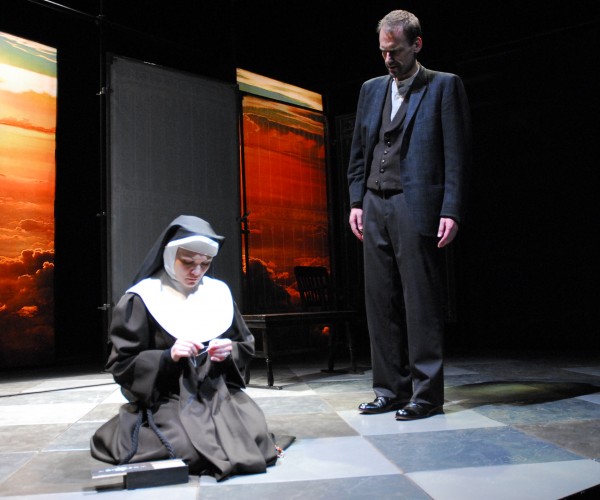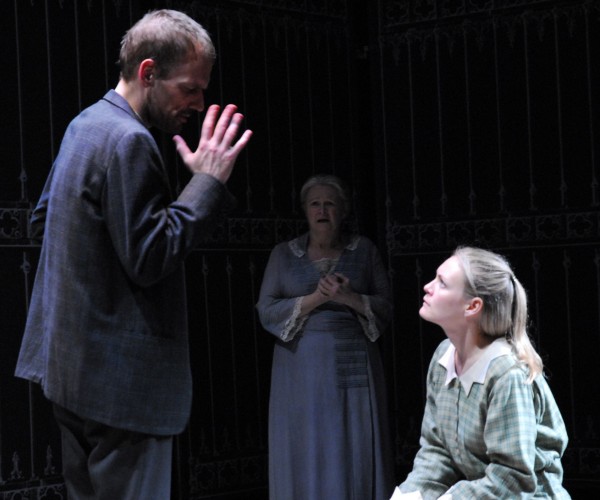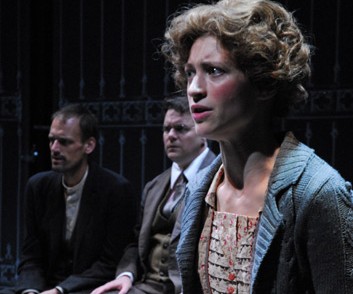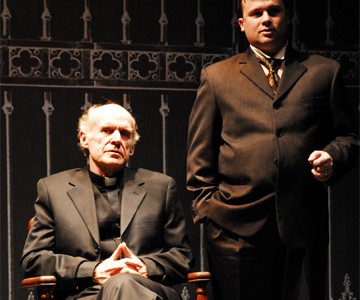Dramaturgy
In his second year of the MFA program at Yale, Milan Stitt was given the assignment of writing an outline for a full length play. He was struggling to come up with an idea, when his wife told him a story she had heard as a child in Traverse City, Michigan. In the small town of Isadore, just a few miles from Traverse City, a nun had gone missing. Years later, her bones were found buried underneath the rectory. Stitt loved the idea and began working on the play in 1965. He had no idea that this little school assignment would become his most famous work, nor did he guess that it would occupy the next eleven years of his life.
The true story of the missing nun was an even longer saga. It all began in 1906, when a nun named Sister Mary Janina was sent to teach at a small convent-school in the remote town of Isadore, Michigan. The convent was comprised of only two other sisters, one priest and the priest’s housekeeper. Less than a year after her arrival at the school, Sister Janina went missing. A massive search was launched, led by the school’s priest, Father Bieniawski. Bieniawski enlisted the help of the church community to form a search party, and when that failed he called in the county sheriff. Search dogs were given the nun’s rosary for scent and they scoured the church grounds with no results. Every few months for the next three years, the investigation would resume and a small clue would be found, but to no end. Ultimately, Father Bieniawski and his housekeeper left for another parish. The mystery of Sister Janina’s disappearance remained unsolved for over a decade until church gossip about a murder confession led investigators to the site of Sister Janina’s body. Her bones were buried in the basement of the church rectory. Suspects were rounded up and questioned, and in 1919 the trial of Sister Janina’s murderer began.
Aside from a chapter in Larry Wakefield’s book The Butcher’s Dozen, about thirteen famous Michigan murders, and a now out-of-print novel The Errant Nun by H. Milostan, the story of Sister Mary Janina lived on only in rumor and folklore until Stitt wrote his play.
Stitt wrote his first full version of The Runner Stumbles shortly after graduating from Yale. He took the script to an agent and was told to make conflicts in the Catholic Church a more prominent part of his play. Stitt ended up with a long theological play that nobody wanted. Stitt received many other suggestions—including the idea of writing a nude love scene between the priest and the nun—but all were fruitless. One producer suggested he make over the play as a courtroom drama. The idea didn’t work, but Stitt was inspired to visit the site of the original Isadore tragedy to review the courtroom documents. He was surprised to find that one of the witnesses at the trial had spoken three lines exactly as he had written them. When he visited the rectory, he discovered that it had been hit by lightening the day before his visit. Inside, he recognized the wallpaper. It looked just as he had imagined it, the same color and design he had described in his play.
Taking all of this as a sign, Stitt returned to his original script and began reworking and simplifying it. He focused on the conflict between the priest and the nun, which he now saw as the conflict between the contained spirit and the free spirit.
After going through three major revisions, three agents and several producers, the script was finally sent to actor Austin Pendleton. Pendleton had starred on Broadway in Mike Nichols’ 1967 revival of The Little Foxes and the 1973 film The Thief Who Came to Dinner, but recently Pendleton had been devoting more of his time to directing. Pendleton was looking for a new project after directing the award winning Broadway musical Shelter. The Runner Stumbles lay in a pile of manuscripts for six months before Pendleton finally got around to reading it. He was instantly intrigued by the project and took the script to Manhattan Theatre Club’s Artistic Director, Lynne Meadow, who set up a showcase performance of the play. In attendance were Del and Margot Tenney, who were about to start up the Hartman Theatre Company in Stamford Connecticut. They wanted The Runner Stumbles to be a part of their premiere season the following year. That gave Pendleton and Stitt a full year to fine tune the script.
The Runner Stumbles opened at the Hartman Theatre on December 30, 1975. A handful of New York critics made the trip to Connecticut to see the production. One of them was Clive Barnes, who called it “one of the best first plays I have seen in a long time.” He wrote that Stitt’s unusual style had turned a classic tale of celibacy and love into an “absolutely fascinating” play. Barnes admitted that the play got to him, and he cried.
On May 18th, 1976, The Runner Stumbles opened on Broadway at the Little Theatre. Pendleton kept the original cast from the Stamford run. The cast were by no means stars, although they were well-respected. Stephen Joyce (Father Rivard) had a long list of television credits, including Rawhide with Clint Eastwood, and a few Broadway credits, including The School for Wives at the Lyceum. The New York Times Mel Gussow noted that Joyce had the most difficult role because of Father Rivard’s challenging shifts in mood, yet Joyce handled “the ruptures in temperament with extraordinary agility.”
Critics were especially fond of newcomer Nancy Donohue as Sister Rita. Barnes wrote that Donohue “can give innocence a meaning, and winkle out the sentiment in sentimentality.” Linda Lawrence singled out Donohue as well, but also commended the entire cast. Despite the performances, Lawrence felt that the play seemed like a work in progress, “still in the process of becoming.”
The first few days after opening night, the theater was near empty. But after mostly positive reviews and word of mouth, the theater slowly filled. Ultimately the show would run for nearly four hundred performances and was listed as Best Broadway Play in the 1976 Burns Mantle Best Play Series.
In 1979 a film version of the play was produced with Stanley Kramer as director. Kramer had been nominated for three Oscars as director of The Defiant Ones (1959), Judgment at Nuremberg (1961) and Guess Who’s Coming to Dinner (1962). Unlike the stage version, the film featured a star-studded cast including Dick van Dyke as Father Rivard, Kathleen Quinlan as Sister Rita and Maureen Stapleton as Mrs. Shandig. The critics did not respond well to the film adaptation, criticizing Kramer’s direction in particular. Janet Maslin of The New York Times wrote that “Mr. Kramer is evidently at a loss…an all-star cast is probably not what an already distracted film like The Runner Stumbles needed.” Both Rex Reed and Roger Ebert found the flashbacks from the courtroom scene “annoying.” But Archer Winstein found merit in the tale itself, “a beautiful, muted, tragic story.” Even Ebert admitted that in “it’s relentlessly old-fashioned way, The Runner Stumbles has a sort of dramatic persistence: it’s not great, but it’s there.”
The high profile of the film may have contributed negatively to the play’s reputation – something we feel should be righted. For beyond amateur and community theatre productions, The Runner Stumbles hasn’t been seen in New York City since its original Broadway run. As for Milan Stitt, he went on to write several other plays including In the Pursuit and Take a Little Chance and his teleplay Long Shadows was nominated for Best Teleplay at the 1996 International Emmys. The Runner Stumbles, however,remains his best known work. The Broadway productiongave Stitt some closure on the eleven year project. “It hardly seems there was a time before I wrote it,” he told the New York Times. “I kept thinking that in six months this part will all be over—the part where no one knows I’m a playwright except me.”






